So, how would different devices built by various manufacturers, such as an intelligent light control system, a smart lock, an agricultural drone, a heart rate monitoring device, or an autonomous vehicle, communicate with the external world?
IoT devices need an IoT gateway, a central hub to serve communication with external networks, a central hub to drop data or receive intelligence from the cloud.
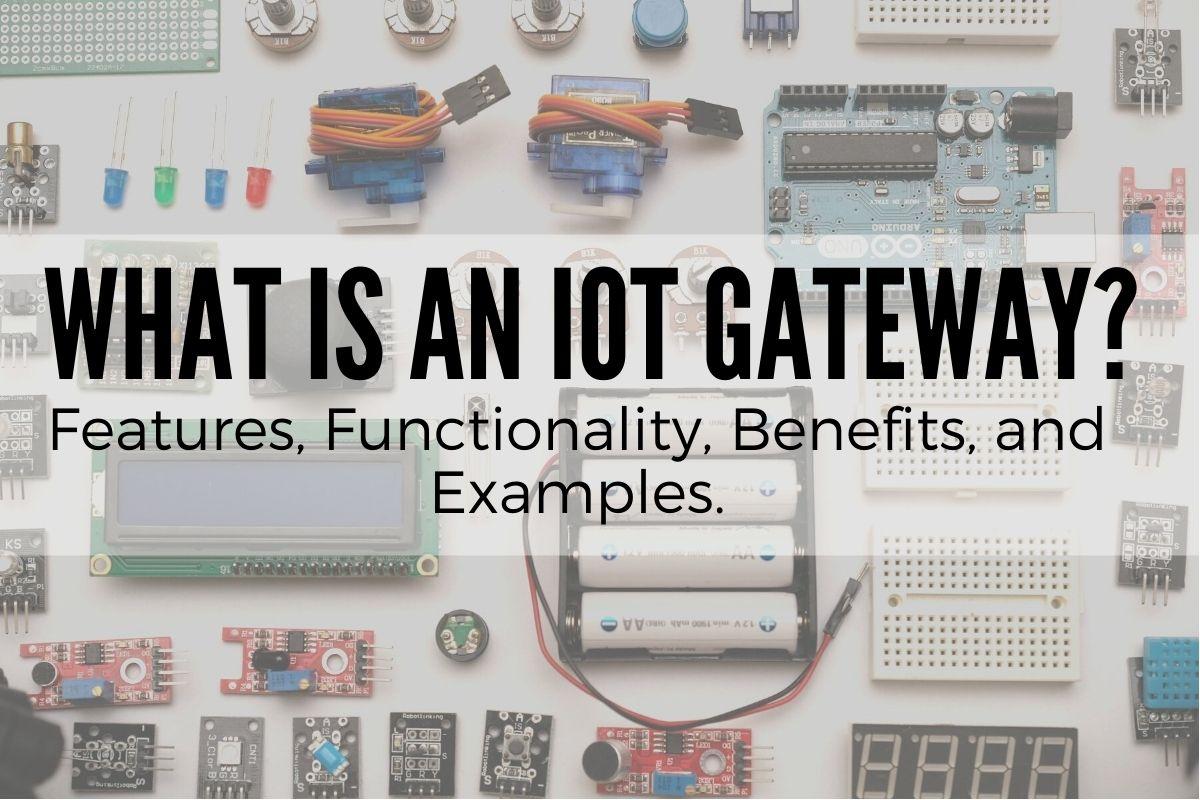
1.What is an IoT Gateway?
In a nutshell: An IoT gateway is a device (physical or virtual) that connects IoT sensors, cameras or any smart device located in one network to another network, usually the Cloud. The IoT gateway connects different types of IoT devices running other interfaces and protocols with the Internet.
IoT Gateway: An In-depth definition.
In the telecommunications realm, the primary purpose of a “Gateway” is to enable communications between two networks with different technologies, including connectivity types, interfaces, or protocols. A gateway is an entry (and exit) point for all network data. In other words, the gateway handles inbound and outbound traffic.
As you read this online, you are most likely connected to an Internet gateway from your mobile or computer. Your Internet Gateway (or router) at home connects your Local Area Network (LAN) with your Internet Service Provider (ISP). This gateway links the ISP’s WAN through technologies like PPP or HDLC with your LAN working with TCP/IP.
The IoT Gateway follows the same principle as your network router: It creates a bridge between the various IoT devices (and their massive generated data) and other networks such as the Internet. All the data moving between IoT devices and the Cloud will pass through the IoT gateway. An IoT gateway may also be referred to as a smart gateway or control tier.
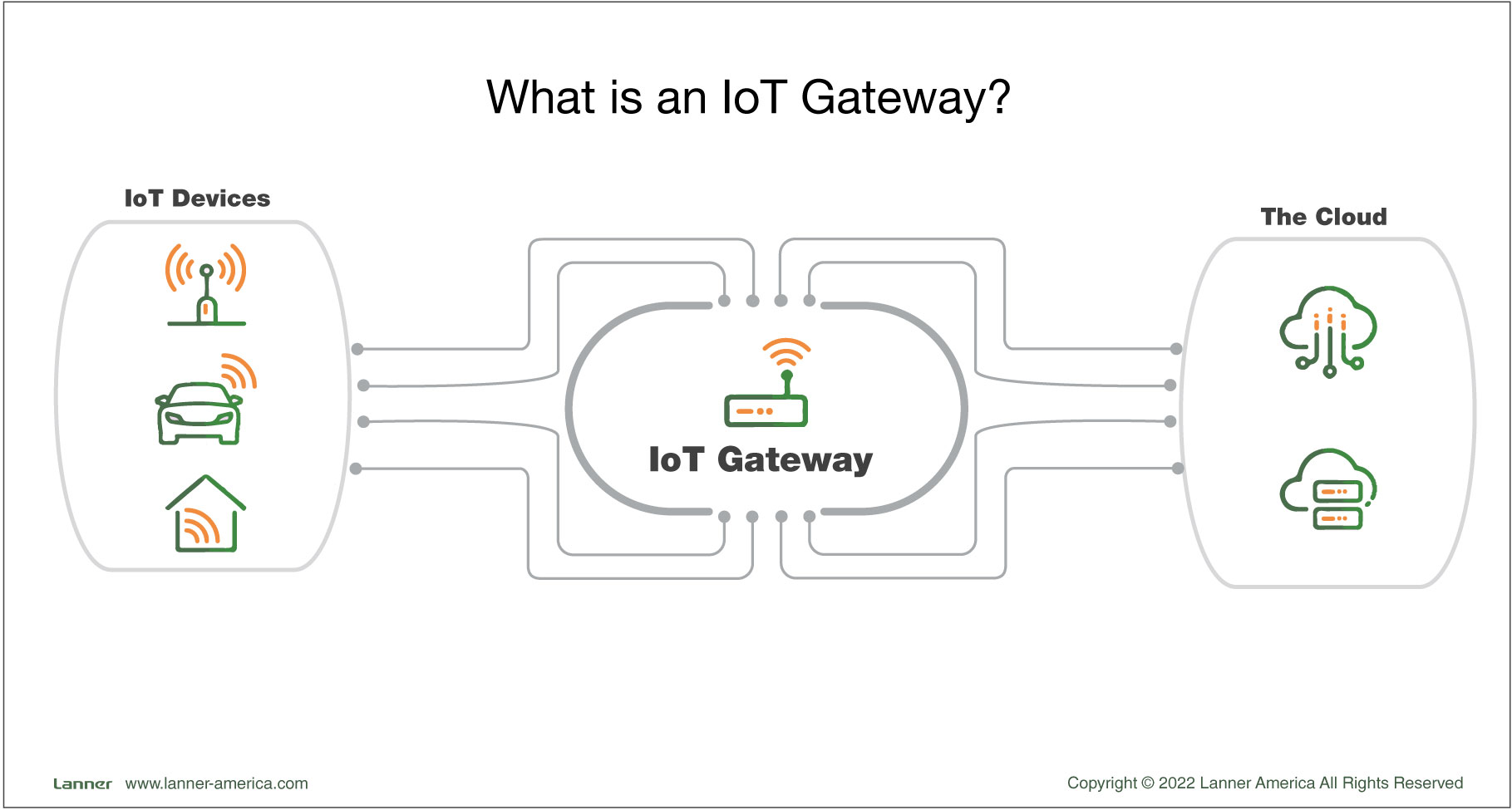
2.How does an IoT Gateway work?
An IoT gateway performs the following tasks (refer to the diagram below).
a.IoT gateways translate protocols to establish communications.
The distributed IoT devices may connect to the IoT gateway using wireless or wired communications. IoTs may use transmission mediums, including short-range wireless transmission modes such as Bluetooth LE, Zigbee, Z-wave, or long-range like LoRa, LTE, LTE-M, WiFi. The IoT gateway should receive and send data using one or more of these transmissions. For outbound traffic, the IoT gateway may also use WiFi, 4G, or 5G or Fiber Optics WAN (HDLC/PPP) to forward data to the Cloud.
The IoT gateway may also understand transmission modes and protocols like MQTT, CoAP, AMQP, DDS, Websocket and translate them to other protocols that the data systems needs.
b.IoT gateway may pre-process the raw data collected by IoT devices.
An IoT gateway receives large amounts of distributed raw data from the IoT devices. Some IoT gateways can aggregate, correlate, and synchronize all this raw data to reduce data volume and thus network latencies. The IoT gateway establishes communication to the Cloud (or high-end server) and sends this “pre-processed” data. This process is referred to as edge computing.
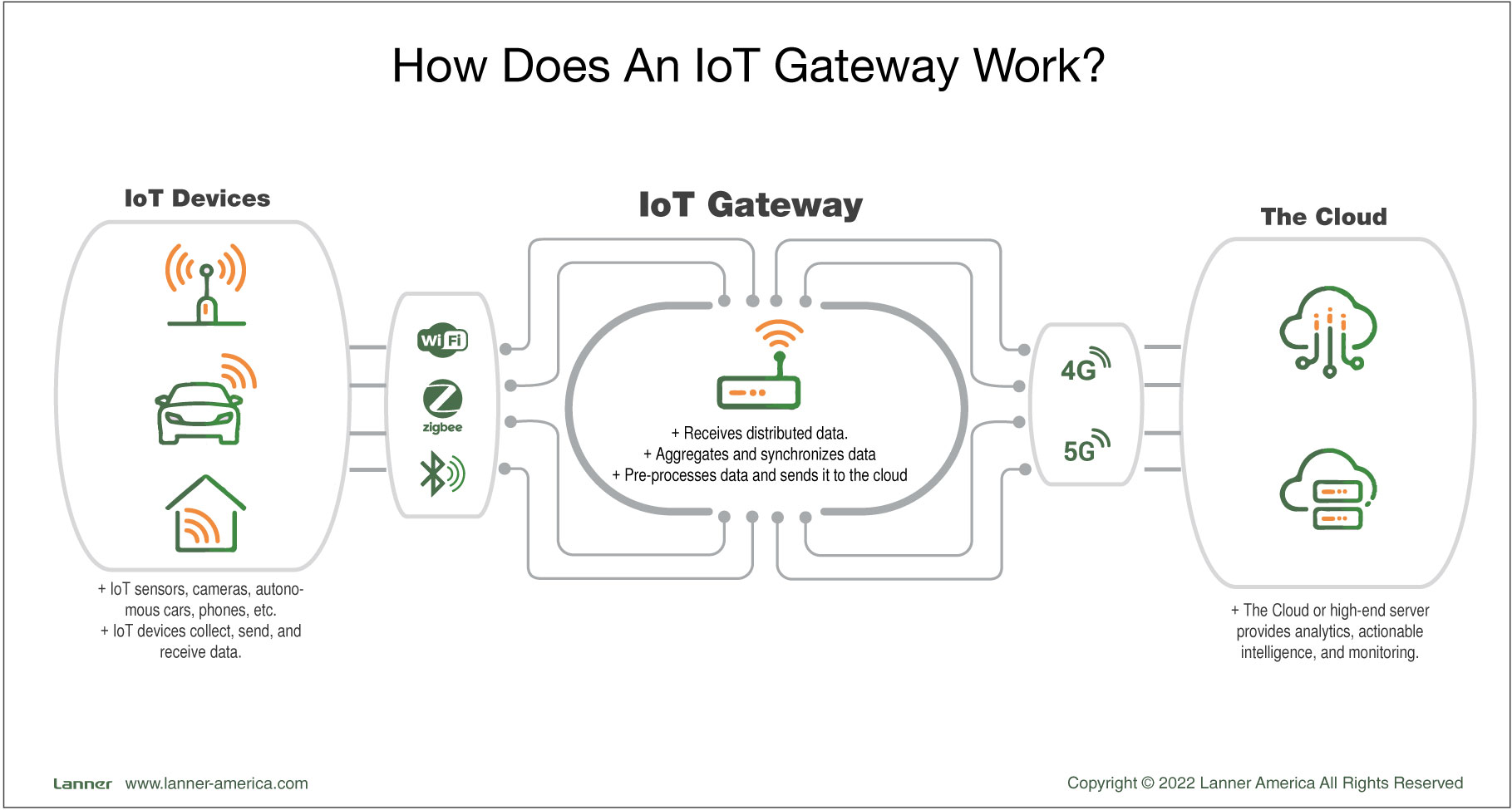
3. Basic and Advanced IoT Gateway Features
Not all IoT gateways are built with the same capabilities and for the same applications, but they should (at least) come with the following basic features. The sophisticated and challenging IoT-enabled applications may require advanced IoT gateways, such as the Industrial IoT gateway.
Basic Features.
- Wired and wireless communications. IoT gateways provide communications to diverse devices with different transmission types, such as LoRA, WiFi, Cellular, Ethernet, and more.
- IoT gateways reinforce security. IoT gateways segregate the network. For instance, they separate OT and IT domains in industrial environments or IoT networks and the public Internet while still providing communication.
- They handle outbound and inbound traffic. An IoT gateway handles outbound traffic for sending IoT data to the cloud and inbound traffic for IoT device management and configuration.
Advanced Features.
- Some IoT gateways may perform edge computing. Edge computing allows IoT gateways to pre-process (aggregate, deduplicate, or summarize) raw data before sending it to the cloud.
- Advanced IoT gateways provide more interfaces for I/O. An Industrial IoT gateway may come with Serial, USB, HDMI, SPI, ModBus, and more interfaces.
- Ruggedness for challenging environments. Rugged IoT gateway appliances such as Industrial IoT gateways are designed for challenging and complex industrial environments. These devices can endure temperatures, vibration, humidity, shock, and more.
- Customizable firmware. Some IoT gateways come with customizable firmware so that the device can adapt to specific applications. For instance, (FOTA) Firmware Over The Air updates allows massive IoT updates via wireless.
- It handles advanced inbound traffic. The IoT gateway may be used for providing additional intelligence and capabilities to the IoT-enabled network. For instance, to support services with offline computing, real-time management, or serve as a data cache, buffer, and streaming device.
4. What are the benefits of using an IoT Gateway?
a.Pre-process data at the edge to improve response times.
IoT gateways can do more than routing traffic. Advanced IoT gateways can pre-process data locally before sending it to the cloud. It may provide local software-driven intelligent capabilities, known as edge computing. The device uses this “local power” to deal with massive amounts of IoT-generated raw data. An IoT gateway uses edge computing to aggregate, deduplicate, and summarize these large volumes of data and reduce the raw data overload. Not having to send massive data improves the network response times, reduces the need for more bandwidth, and ultimately lowers transmission costs.
b.Reinforce IoT-enabled network security.
The IoT ecosystem grows so rapidly that standardization organizations can’t keep up. There is currently a lack of manufacturing standards, especially within security. Although different organizations are already working on IoT standards, it is still ongoing. IoT devices come with poor security, including weak default passwords, insecure network services, insecure interfaces, lack of update mechanisms, and more. An IoT gateway provides the first line of defense for these potentially insecure devices against the Internet. All IoT devices must use the IoT gateway to communicate, making it a kind of proxy device. For instance, a rugged Industrial IoT Gateway should be essential for ICS/OT Security. In addition, some IoT gateways come with security mechanisms like TPM 2.0 to ensure fast full encryption.
c.Improves energy efficiency on the IoT devices
Most of the time, smart cities, factories, or farms use applications with IoT sensors (or actuators) that are deployed remotely. This entails that such IoTs need to be highly autonomous in energy. They need efficient and powerful radios to send data to cellular towers or satellites, a process that consumes large amounts of power. Applications like this usually fail because such IoT devices have limited battery life, and in other cases, they do not support energy-hungry radio technology like LTE or WiFi. But a nearby IoT gateway connected to the power grid can serve as a bridge to shorten those signal ranges and manage all sensor’s communication. Some IoT gateways may also provide PoE (Power over Ethernet) capabilities to use networking cables to power devices up.
d.It withstands harsh and industrial environments.
Although a commercial IoT gateway would provide all the above benefits, a commercial IoT gateway is not the same as an Industrial IoT gateway. Industrial IoT (IIoT) gateways provide all the above benefits, plus they resist extreme environmental and industrial conditions. IIoT gateways are built with robust materials fanless technologies and usually comply with standards like the IP67 or MIL-STD-810G. Such IIoT gateways can withstand wide-ranging temperatures, humidity, vibration, shock, radiation, water, dust, and even explosions.
5. IoT Gateway Examples and Applications.
Below are some examples of real-use case scenarios where IoT gateways could be used. Every application comes with an example of a real IoT gateway appliance. There are multiple classes and types of IoT gateways, but the ones here are appropriate for each case.
a.A rugged Industrial IoT Gateway is essential for ICS/OT Security.
A rugged Industrial IoT Gateway should be an essential component for IT/OT or ICS/OT Security. For instance, an Industrial IoT can improve their security on a manufacturing floor by separating IT from OT networks. Manufacturing floors are challenging industrial areas, so no simple IT firewall or router could be placed here. An IoT gateway for this industry is designed for low power consumption, high processing performance, security capabilities and is ready for extreme environments.
An IoT Gateway is also an essential component in the integration of PLC (Programmable Logic Controllers) usually found in manufacturing floors with IoT.
An example of an Industrial IoT Gateway is LEC-6041:
- Wide temperature tolerance
- ICS Cyber Security Box.
- High processing capability
- Din-rail for mounting in racks.
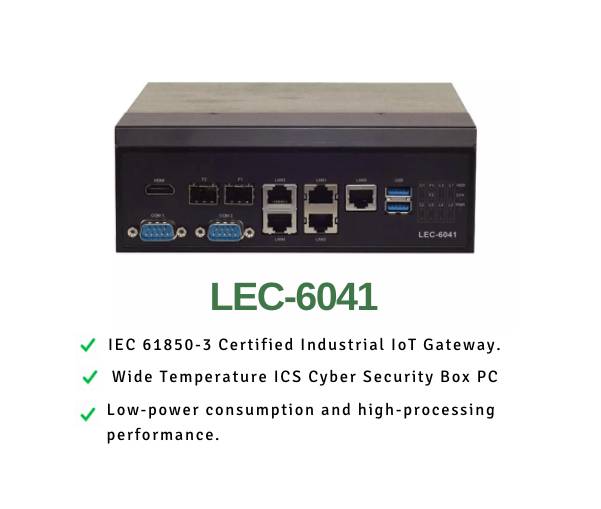
b. An IoT gateway to handle healthcare imaging devices.
IoT imaging devices within the healthcare sector can help radiologists adjust external factors such as the light setting of the room and control radiation exposure. In addition, these intelligent devices can also have X-rays sent to the Internet and use ML and AI services on the cloud to analyze thousands of high-quality X-ray images.
An IoT gateway can forward large volumes of image data and provide healthcare security. An example of this type of IoT Gateway is the LEC-7230.
LEC-7230 can provide the following functionalities.
- Improved graphical and media performance. Rich I/O: VGA, HDMI, and USB 3.0.
- Small form factor.
- Fanless and robust.
- Secure content delivery.
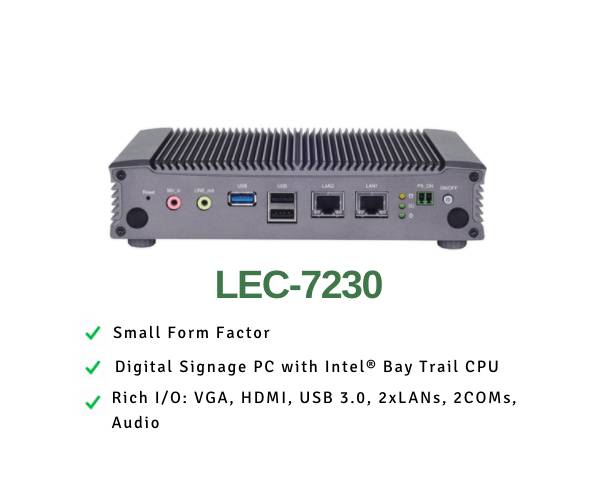
c. In-Vehicle IoT Gateway to provide Vehicle Area Networks (VAN)
Emergency response vehicles such as EMS, fire, or police need IoT devices such as cameras, radars, mapping systems, or sensors to improve and make their jobs easier. An in-vehicle gateway can provide safe and reliable access to these IoT devices within a VAN to external networks, such as the Cloud.
Emergency response vehicles are in constant movement, high speed, rough terrains, etc., so they need equipment built for this purpose. These in-vehicle gateways must be rugged — from anti-shock, waterproof, anti-dust, temperature-proof, and humidity-proof. These devices also need to support cellular communications such as LTE.
Examples of this type of IoT gateway are the V3S or V6S.
- It can be bolted and installed on the trunk or in a safe location in the vehicle.
- High processor unit and high-speed ports (PoE Switch)
- 2G (GSM), 3G (GPRS) or 4G (LTE).
- This product can be extended to be compatible with Private-LTE and FirstNet, by integrating with an LTE module like PGN-600.
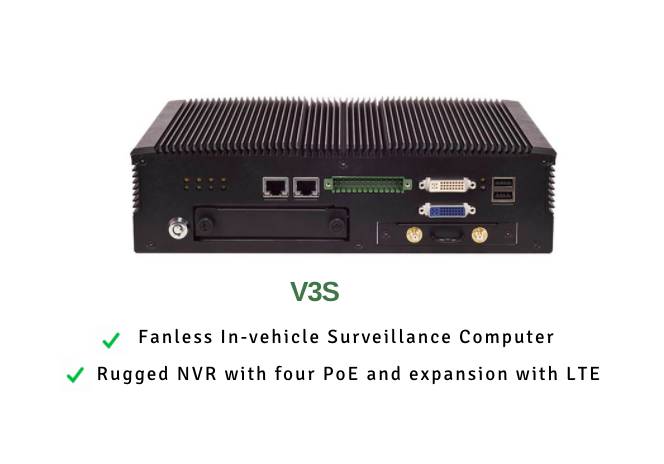
IoT Gateway FAQ.
- Are IoT gateways secure? Yes, an IoT gateway provides the first line of defense for insecure IoT devices and networks. It also segregates the OT and IT networks to protect industrial assets from being hacked.
- IoT gateway vs. IoT module? IoT modules are small embedded computers deployed on machines or objects. The IoT module is designed to provide Internet connectivity to physical devices. On the other hand, an IoT gateway would help different IoT modules connect to the Internet.
- IoT gateways vs. IoT controllers? The IoT controller (usually software-based) provides network management, orchestration, security, and control for the IoT devices. IoT controllers can orchestrate IoT devices from different vendors. However, an IoT controller does not route traffic from network to network, as an IoT gateway does.
- IoT gateway vs. router? So, what are the differences between IoT gateways and routers? Although a router or home Internet gateway may also provide Internet connectivity to an IoT device, a router may be limited to technologies such as WiFI, Ethernet, and sometimes 4G. On the other hand, An IoT gateway is ready for different protocols and technologies such as Bluetooth, Zigbee, WiFi, LoRa, LTE, 5G, Ethernet, Serial, and more. Plus, IoT gateways also come with edge computing capabilities.
Final Words
Without gateways, our Internet-enabled devices couldn’t communicate with the Cloud or remote high end-servers. Like a traditional router, a gateway enables communications between two different networks. An IoT gateway takes this concept further by allowing devices with diverse interfaces and protocols to communicate with the cloud.
The IoT gateway is a crucial element in IoT ecosystems. It is the bridge of communications— it connects Zigbee sensors with the Internet, Bluetooth devices with a native-cloud application, and more. It helps reduce latency and improve capacity at the edge by pre-processing raw information. The IoT gateway also provides an extra security line in these vulnerable environments.









